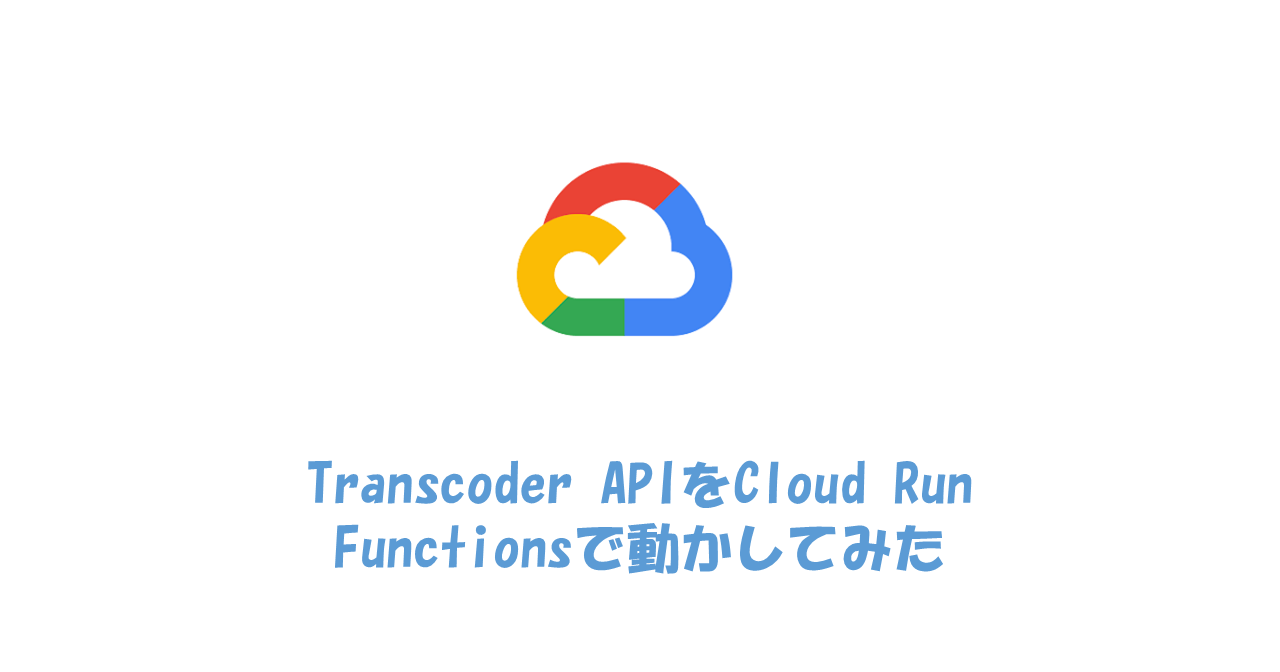こんにちは!大嶋です!
みなさんは動画を変換するときに何を使っているでしょうか。
今回はGoogle Cloudが提供しているTranscoder APIをCloud Run Functionsを使って動画を変換する方法を紹介したいと思います。
本記事でわかること
- Transcoder APIの概要
- Cloud Run Functionsを使った時の実装方法
Transcoder APIの概要
Google Cloud Transcoder APIは、動画の変換(トランスコード)を行うための強力なツールです。このAPIを使用することで、さまざまな解像度やビットレートに動画を変換し、異なるデバイスやネットワーク条件に最適化することができます。
Transcoder APIのメリット
- サーバーレスアーキテクチャ: Transcoder APIは完全にマネージドなサービスであり、インフラストラクチャの管理が不要です。これにより、Cloud Functionsなどのサーバーレス環境で簡単に利用できます。
- 高いスケーラビリティ: Google Cloudのインフラストラクチャを利用することで、大量の動画を高速に処理することができます。
- コスト効率: 使用した分だけ課金されるため、コストを最小限に抑えることができます。
- 多様なフォーマット対応: 多くの動画フォーマットに対応しており、さまざまなデバイスやプラットフォーム向けに最適化された出力を生成できます。
- 簡単な統合: 他のGoogle Cloudサービス(Cloud Storage、Cloud Functionsなど)とシームレスに統合できるため、ワークフローの自動化が容易です。
- 高品質な出力: Googleの高度なエンコーディング技術を利用することで、高品質な動画出力が可能です。
Cloud Run Functionsを使った時の実装方法
前提条件
- Google Cloud Platform (GCP) アカウント
- gcloud CLIがインストールされていること
- Cloud FunctionsとTranscoder APIが有効化されていること
実装
今回は以下のディレクトリで、動画のHLS変換と解像度の変換をpythonで行います。
my-transcoder-function/
├── main.py
└── requirements.txt
main.py
import os
import time
from google.protobuf import duration_pb2
from google.cloud.video.transcoder_v1 import TranscoderServiceClient
from google.cloud.video.transcoder_v1.types import Job, JobConfig, ElementaryStream, MuxStream, VideoStream, SegmentSettings, Manifest
def transcode_video(event, context):
try:
print("Starting transcode_video function")
client = TranscoderServiceClient()
project_id = os.getenv('GCP_PROJECT')
location = 'asia-northeast1' # 必要に応じてリージョンを変更
input_uri = f"gs://{event['bucket']}/{event['name']}"
output_uri = f"gs://{os.getenv('OUTPUT_BUCKET')}/{event['name']}/"
input_filename = os.path.splitext(event['name'])[0]
job = Job(
input_uri=input_uri,
output_uri=output_uri,
config=JobConfig(
elementary_streams=[
ElementaryStream(
key='video_1440p',
video_stream=VideoStream(
h264=VideoStream.H264CodecSettings(
height_pixels=1440,
width_pixels=2560,
bitrate_bps=8000000,
frame_rate=30
)
)
),
ElementaryStream(
key='video_2160p',
video_stream=VideoStream(
h264=VideoStream.H264CodecSettings(
height_pixels=2160,
width_pixels=3840,
bitrate_bps=12000000,
frame_rate=30
)
)
)
],
mux_streams=[
MuxStream(
key='qhd',
container='ts',
elementary_streams=['video_1440p'],
file_name=f"{input_filename}_1440p",
segment_settings=SegmentSettings(segment_duration=duration_pb2.Duration(seconds=6)) # デフォルト6秒
),
MuxStream(
key='uhd',
container='ts',
elementary_streams=['video_2160p'],
file_name=f"{input_filename}_2160p",
segment_settings=SegmentSettings(segment_duration=duration_pb2.Duration(seconds=6)) # デフォルト6秒
)
],
manifests=[
Manifest(
file_name=f"{input_filename}.m3u8",
type_='HLS',
mux_streams=['qhd', 'uhd']
)
]
)
)
parent = f"projects/{project_id}/locations/{location}"
response = client.create_job(parent=parent, job=job)
print(f"Created job: {response.name}")
except Exception as e:
print(f"Error: {e}")requirements.txt
google-cloud-video-transcoder==1.13.0
protobuf==5.28.3今回は、自分の指定したバケット内でのファイル作成をトリガーにして実装します。
gcloud functions deploy transcode_video_hls \
--gen2 \
--runtime python39 \
--trigger-event google.storage.object.finalize \
--trigger-resource "インプット元バケット" \
--entry-point transcode_video \
--region asia-northeast1 \
--set-env-vars GCP_PROJECT="プロジェクトID",OUTPUT_BUCKET="アウトプット先バケット"上記まで実装できたら実際にバケットに動画を格納して、動作確認をしてください。
まとめ
以上で、Google Cloud Functionsを使用してTranscoder APIを実装する方法についての解説は終了です。これで、高解像度の動画変換を自動化するための強力なツールを手に入れることができました。Transcoder APIのメリットを活用して、効率的に動画変換を行いましょう。ぜひ試してみてください!
おわり。
Google および Google Cloud Platform™ service は Google LLC の商標であり、この記事は Google によって承認されたり、Google と提携したりするものではありません。



コメント